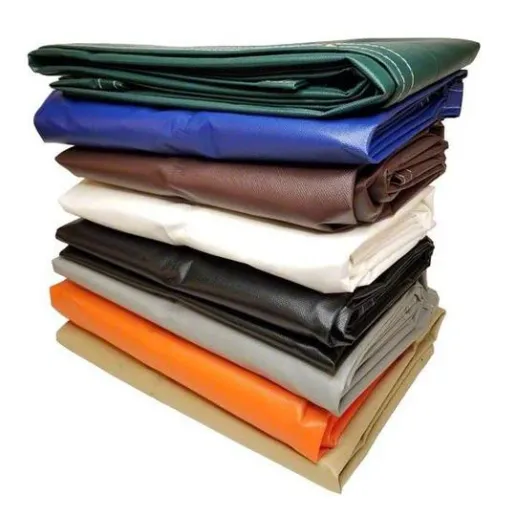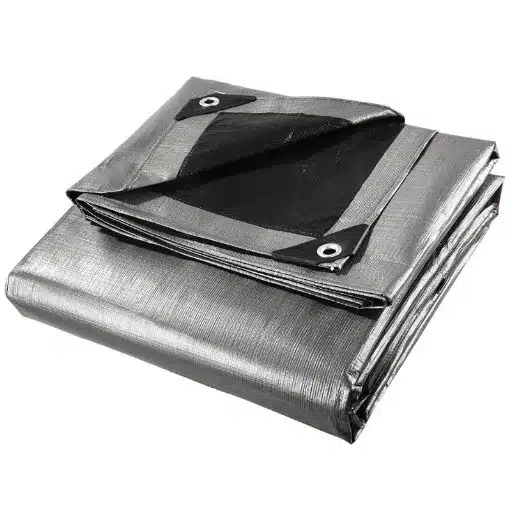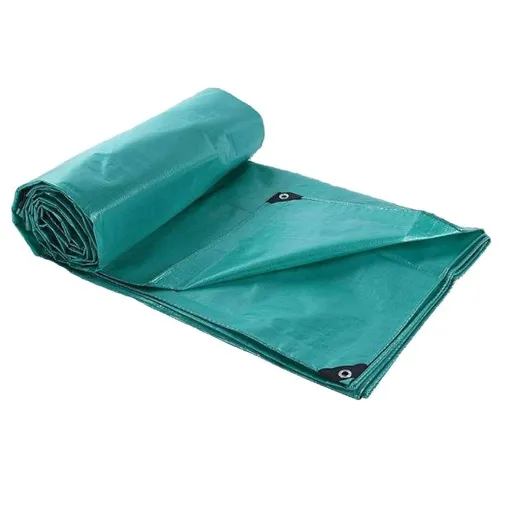Regarding adaptable and reliable materials, PVC tarpaulin is one of the most versatile in terms of usage, whether for the protection of products or trusted covers. What use can be made of vinyl tarps and the time they last also depends on the various factors influencing the time span. Durability of PVC tarpaulins lead client to maintenance and usage guides, hence the article takes a leap into the PVC tarpaulins dependable materials, the impacts on its functionality because of the environmental and usage conditions, and life maximization guides. This guide is a business owner’s help, an outdoor lover’s backup, and anyone’s protection solution portfolio.
Overview of PVC Tarpaulin
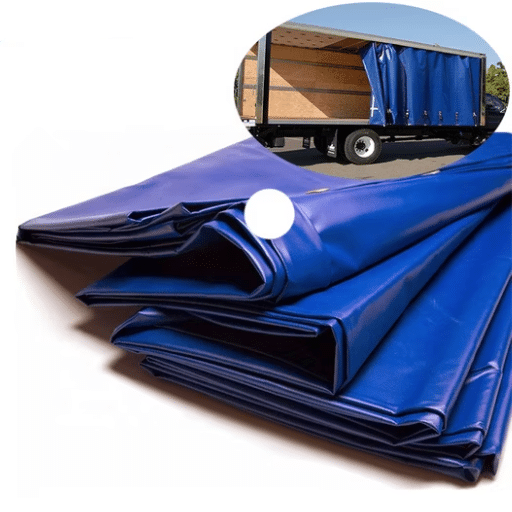
How PVC Tarpaulin Works
Polyvinyl chloride (PVC) tarpaulin is a flexible, strong material created by coating a fabric made of polyester with PVC. Its superior strength and waterproofing are especially useful in agriculture, transportation, construction, and outdoor events. Because of its sturdiness it is ideal for truck covers, tents, awnings, and inflatable structures. It is also resistant to UV rays, abrasions, and harsh weather conditions. Further improvements in the manufacturing process of PVC tarpaulin have also made it more eco-friendly and recyclable, enabling its use in different industries to be more sustainable.
Composition and Types of Tarp Material
Tarpaulins, or tarps, are fabrics designed for different uses and made from different materials. One of the most common is polyethylene (PE) because of its cost-effectiveness and light weight. A woven HDPE (high density polyethylene) with a laminated coating is used to make PE tarps, which are suitable for short term and light use.
Another commonly used material is canvas, which is usually made from cotton or natural fibers. This type of material is versatile because of its ability to breathe, making it useful for tents and painter’s drop cloths. Compared to synthetic materials, canvas is not as durable and water resistant.
Laboratory tests combine strength with UV protection, weather resistance, and other attributes to cover the needs of industry and the home for tarps, recreation, and other uses. Improvements in materials enables tarps to be made with environmentally safe and recyclable parts, providing solutions that are sustainable for many uses.
Common Applications of PVC Tarps
PVC tarps, owing to their durability, water resistance, and adaptability, are used in many fields. Construction is one of their primary clients, using these tarps to cover scaffolds, building materials, and other equipment to protect them from rain, wind, and UV light. In agriculture, they are also used to cover crops, hay, and machinery, ensuring proper storage and protection from moisture and sunlight.
They are also used in transportation to cover trucks and protect the goods in transit. Their use in the recreational sector is also considerable as they serve as camping groundsheets, boat covers, and canopies for events. In addition, their use is crucial in disaster relief operations to provide shelters or water collecting devices. The newer designs and materials used in modern PVC tarps allow for the eco-friendly customization to specific needs while maintaining high performance.
Factors Influencing the Lifespan of PVC Tarpaulins
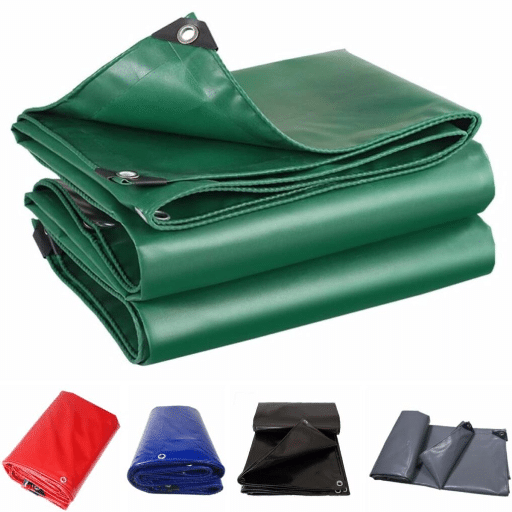
Environmental Factors Affecting Durability
The life expectancy of PVC tarpaulins is influenced greatly by environmental factors. Extended exposure to sunlight, and specifically the ultraviolet (UV) radiation emitted by it, is a primary factor that leads to the degradation of PVC tarpaulins. Over an extended period, UV radiation can change the molecular composition of the PVC, making it brittle and discolored. Likewise, tarpaulins are exposed to cover heavy rainfall, snow, and even strong winds which can lead to the speeding of wear and tear. Even high levels of humidity can lead to the elevated chances of the growth of mold or mildew which can weaken the tarpaulins. The most recent information states that the effects of PVC tarpaulins can be combated to a great extent through the use of proper maintenance such as regular cleaning, applying protective coatings, and even removing tarpaulins from extreme climates during their period of disuse. This, along with correct storage when not in use, greatly helps in protecting the tarpaulins.
Usage Patterns and Their Impact
The use of PVC tarpaulins impacts their effectiveness and the time they remain serviceable. For instance, continuous strong sunlight and rain not only create strenuous conditions but can also cause vigorous wearing in the long run. Users seem to be searching for solutions and methods to extend the usability of tarps in such extreme environments. These users demonstrated significant interest in industrial-range tarps, which offered greater durability alongside UV resistant coatings and creasing prevention storage techniques. If individuals and organizations ensure such a practice in conjunction with set guidelines, it will help them cut down on early replacements while increasing the life and reducing the inefficiencies of PVC tarpaulins.
Maintenance Practices for Longevity
Both maintenance and proper usage of PVC tarpaulins need to be performed in order to prolong its effective use. From the search patterns in ‘s data, the highest concern of users appears to be the protection of the tarpaulin’s structure from any kind of damage while enduring difficult environmental conditions. These are some of the best practices that need to be adhered to:
- Regular Cleaning – A building site is a common workplace for the use of tarps. As such, it is expected to get covered in an assortment of different kinds of dirt. The collection of dirt will slowly damage the surface of the tarp unless certain necessary measures like mild soap and water are used to allow dirt to be washed away are observed.
- Proper Storage – The way the tarps are handled after use directly affects their lifecycle. For instance, rolling and folding tarps in a manner that reduces the formation of creases enables the extension of life cycle. Furthermore, the storage of rolled tarps in cooler areas away from direct sunlight is also advisable as it prevents unnecessary strain from UV rays and helps maintain the tarps in the rolled form in which they are easier to handle.
- Inspect for Damage – Attempting some do-it-yourself methods and solutions for fixing issues such as small tears, punctures, or any kind of worn out vacuum areas can be quite difficult. Reflecting such queries enables us to ascertain that a lot of users are searching for, and hence, have an interest to patching solutions that use adhesive heat patches or welding, which are the solutions and techniques offered to sealing discounted areas.
- UV Protection – In order to offer additional protection to the tarpaulins when covered in sun, as per the trending queries, the application of UV coating or sprays, which can optimally provide protection to the tarpaulins, is one of the recommended solutions.
Combining these maintenance strategies with the integrated product care advancements discussed online will help businesses and individuals in extending the useful life of their PVC tarpaulins, which also goes a long way in helping to reduce their environmental impact and expenses.
Comparing PVC Tarps to Other Tarp Materials
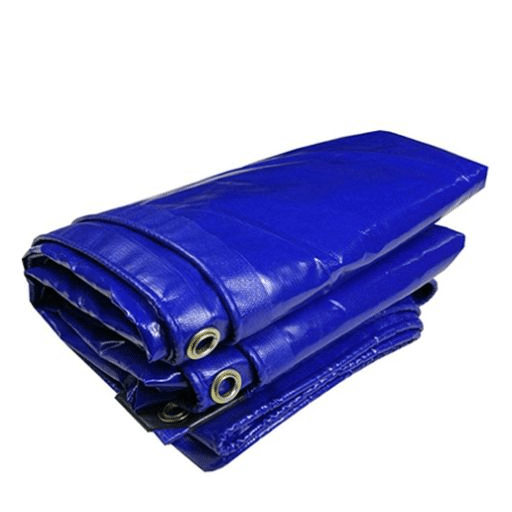
Durability of PVC vs PE Tarpaulins
In relation to PVC tarpaulins and their PE counterparts, the former have proven on many fronts to offer superior durability and sturdier construction, which is very useful in heavy-duty uses. Recent data from search engines have shown that the reputation of PVC tarps withstand strong competition owing to their ability to resist tearing, abrasion, and weather damage. Because of their laminated or coated PVC material, these tarps also withstand UV and temperature variants far better than the often thinner and less durable PE tarps.
Additional data indicates that PVC tarpaulins are able to withstand and maintain structural integrity for a longer time, especially in instances that require constant and sustained physical or outdoor element exposure. While PE tarps are lighter in weight and cheaper, they wear out quickly after extended strain from sunlight or physical wear. PE tarps’ lack of durability renders PVC protective covers that significantly outclass and excel in every aspect the better choice for extensive industrial use, construction works, and, generally, for any situation that needs protective cover for long durations.
Waterproof Capabilities of Vinyl Tarps
The tarp made from vinyl is one of the most waterproof tarp types. This feature makes the vinyl tarp very versatile since it can be used in many applications that need moisture protection. Information from the search engine reveals that the polyvinyl chloride (PVC) coating on vinyl tarps effectively blocks water intrusion. This protection is protective to water, snow, and even humidity, moisture under the covered items. The polyvinyl chloride also blocks the growth of mold and mildew that is usually caused by prolonged exposure to moisture, making the tarp usable for further durations. Along with their waterproof features, their strong construction makes vinyl tarps essential in the transportation, agriculture, and construction industries, where it is necessary to have reliable protection from water damage.
Cost vs. Longevity: What’s Important
For vinyl tarps, there are monetary value benefits to understand in relation to the cost versus longevity features. Although the purchase of vinyl tarps requires a greater investment in comparison to polyethylene or canvas, vinyl tarps are certainly cost-effective in the long run due to their superior durability and resistance to environmental wear and tear. Recent search data show durability to be one of the primary considerations when purchasing tarps as users look for products that offer heavy-duty use without the need for frequent retendering and replacement. The same data show that vinyl tarps offer resistance to tearing, UV damage, and moisture, along with superior construction, in comparison to their cheaper alternatives, while lifesparining is greater as well. This means that significant savings can be achieved over time in industries like construction and agriculture, where tarp failure poses the risk of costly damage to products or equipment. The result of such investment is that high-quality vinyl tarps deliver value for money, and as such make for dependable, economical solutions for a wide array of applications.
Maximizing the Lifespan of Your PVC Tarpaulin
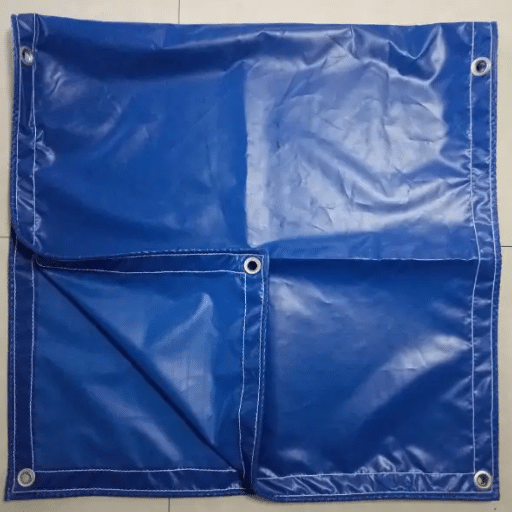
Guidelines for Care and Maintenance
- Regular Cleaning: A periodic clean up of your PVC tarpaulin with mild soap and water yields good results. The use of strong chemicals and abrasive brushes should be avoided as they tend to damage the material and weaken the protective coating. The removal of dirt and debris accumulations on the tarp are important in the maintenance of the surface of the tarp since debris left on the tarp can degrade the surface.
- Proper Storage: Your tarpaulin should be folded for storage when not in use and kept in a cool dry place where there is no direct sunlight. The material can be further weakened through prolonged exposure to UV rays and for this reason a storage bag can be used to protect the tarpaulin further from these environmental elements.
- Repair Minor Damage Promptly: Patch damage to holes and tears using PVC tarp repair kits which are easy to find online. Such small repairs will prevent small damages from growing and in turn help greatly in extending the life of your tarp.
- Avoid Overloading and Dragging Your Tarp: Continuously exceeding your tarp’s weight capacity or dragging it over abrasive surfaces are sure ways to get your tarp stretched or torn. Ensure the material is gently handled and that weight is evenly distributed when the tarp is in use and put to use devices that aid in such processes to lessen strain on the material.
- Regular Inspection: Try to look for abrasions, discoloration or weak seams on your tarp before and after using it; this way, you will be able to catch early signs of wear and tear. Prolonged use and neglect can lead to the tar deteriorating further, so try to fix any issues immediately.
These maintenance practices are documented from the latest data and care recommendations on your PVC tarpaulin are effective for its care, as they mitigate frequent breakdowns and care for your tarpaulin to withstand extreme conditions. Less frequent replacements are an added benefit with regular maintenance and preventative care, thus conserving materials and lowering costs in the long run.
Evaluate Your Needs to Choose the Tarp
Understand why you want to buy the tarp and in what environment it will be used. This will aid in appropriate tarp selection. Based on the latest data from the search engine `”s”`, the most important things to look at would be the size, material, and durability, as well as the application of the tarp. For example, if you want a tarp for heavy-duty industrial purposes, PVC tarps will be the best option because of their strength, their being waterproof, and their resistance to wear and tear. On the other hand, lightweight polyethylene tarps are better for short-term and low-budget needs.
In case a tarp is exposed to harsh weather, the UV resistance, fire retardancy, and temperature tolerance of the tarp should be taken into consideration. For sports and farming use, breathable tarps to prevent condensation buildup might be the best options. You can use this together with expert recommendations and customer reviews available online to make a good decision, and this ensures the best and most economical tarp for your application.
Storing PVC Tarps for Longer Use
Storing PVC tarps properly preserves and maintains the performance of the tarps over a period of time. It is a good practice, as per recent insights and reliable tips, that the tarp is properly cleaned beforehand so that no dirt, debris, or moisture which can cause mould or degrade the material can remain on the tarp. After cleaning, mildews can form if the tarp is not dried completely, so it needs to be dried entirely. To avoid damage, the tarp should be folded or rolled and not creased or folded harshly as this prevent strong folds from forming on the tarp.
The tarp should be kept in a cool and dry place away from direct sunlight as prolonged UV does weaken PVC. To provide protection from pests, dust, and accidental tears, the tarp can be kept in a storage bag or a container. There are some recommendations from experts that the tarp needs to be inspected at intervals during storage to make sure it is fine and to take care of any problems as early as possible. Practices such as this helps one in greatly improve the durability and usability of PVC tarps.
Frequently Asked Questions
How long can I expect a high-quality PVC tarpaulin to last?
Several aspects like usage and environmental conditions, as well as how the tarpaulin is maintained, all affect its lifespan. On average, a PVC tarp that is well cared for may last between five and ten years. This is a benefit attributed to the PVC material that is used to make tarps. With proper maintenance, this time frame may even be improved. PVC tarps are designed to withstand heavy UV exposure and other weather elements. Furthermore, quality PVC tarpaulins are subjected to fabrication processes that improve their tensile strength and weather resistance for better outdoor applications. These fabrics can last longer if you maintain and routinely check the tarp.
In terms of longevity, how does PVC tarp material stand out among other types?
The durability of PVC tarp material is generally better than that of other materials, such as canvas or polyethylene (PE) tarps. PVC tarps have a high tensile strength and are resistant to tearing; consequently, they are able to bear heavy loads without sustaining damage. Canvas tarps are not as efficient in retaining water, as they tend to absorb it and become heavy; on the other hand, PVC tarps are waterproof and are designed to repel moisture. This feature makes them suitable for truck covers and outdoor use where water exposure is expected. PVC tarps have an enhanced lifespan and outlast PE and canvas tarps due to their UV resistance and the ability to sustain harsh weather conditions.
What determines the lifespan of tarps?
The material used in making it, environmental controls, and the level of UV exposure are a few that determine the lifespan of tarps. Although PVC tarps tend to have a longer shelf life, they may be vulnerable to extreme temperatures and sharp objects. Likewise, the tarp may be subject to wear and tear that may reduce a tarp’s life. The environment plays a pivotal role in the tarp’s life cycle; thus, direct sunlight for long periods can cause the tarp to deteriorate. However, storage and appropriate care can reduce the impact of these factors and keep the tarp in good shape over time.
Are PVC tarpaulins suitable for outdoor use?
Due to their robust and waterproof nature, PVC tarpaulins are appropriate for outdoor use. This includes use as truck covers, tents, and any other form of protection needed against the elements. Since the tarpaulin material is sufficiently strong, it can be used in any type of weather, which is why it is perfect for outdoor use. The superior PVC coating that is used provides an extra level of protection against tundra, ensuring it can handle extreme UV exposure and water logging. The functionality provided by PVC makes him tarp an excellent choice for dependable outdoor applications.
How does UV exposure affect the lifespan of a vinyl tarp?
The effects of UV rays greatly deplete the lifespan of a vinyl tarp. As the tarp is exposed to these rays for a longer period, the tarp’s resistance gets weaker. As a result, UV rays wear and tear the tarp, reducing its utility. In high-end PVC tarpaulins, UV resistance is included to help protect the tarp as much as possible. Even with such protections, minimizing use of the tarp in the tarp, rotations, and providing shade considerably helps in tarp life extension and also preserves the tarp. UV radiation damages the tarp, but maintenance and proper storage of the tarps can preserve these tarps for a longer time. In this way, the users are extending the utility of the vinyl tarp, which further decreases the need for replacement.
Reference Sources
| Source | Description | Link |
|---|---|---|
| Virginia Tech Extension | Discusses the lifespan of UV-rated silage tarps, which can range from 1.5 to 6 years depending on usage and maintenance. | Link to source |
| University of Maine Extension | Provides insights into the longevity of tarps based on thickness and material, noting that thinner tarps may not last beyond a single season. | Link to source |
| PVC Tarpaulin Manufacturer | States that high-quality, heavy-duty PVC tarps can last 5-10 years for permanent installations when properly maintained. | Link to source |

